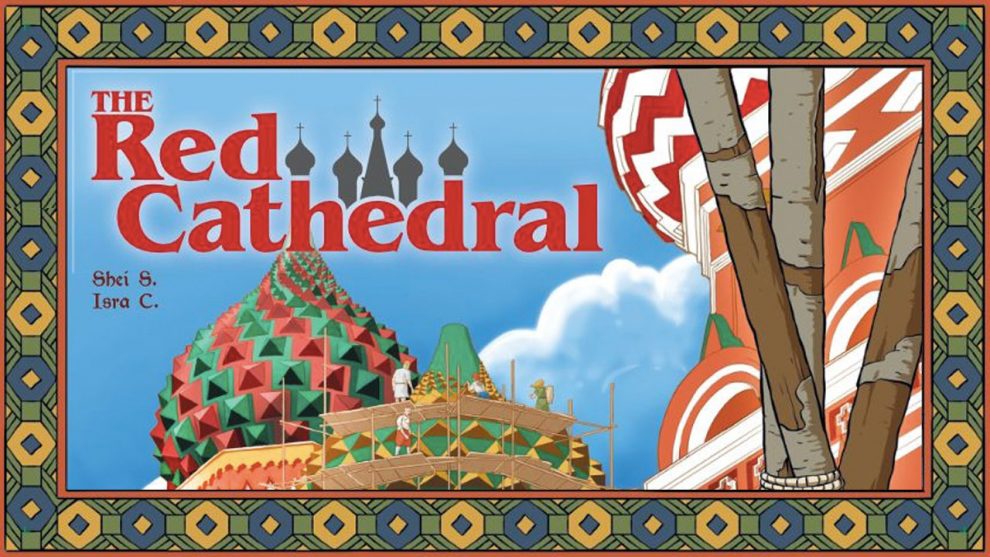
The Red Cathedral fast became one of my favourite games. I don't know when it happened - when I first opened the box, or handled the components, or played the game, or thought about it tirelessly after the fact - but it had a quality that drew me in. By the final turn of my second game, I solidified the opinion bubbling away beneath the surface of my thoughts: This is the best resource management game I've ever played.
Hi. I'm Matt. And I love The Red Cathedral.
More accurately, I love resource management/worker placement games. For some reason, collecting resources and building things does something to my monkey brain that is intensely satisfying. There is a want to plan, but a need to improvise, and trying to balance both makes for a delicious, crunchy puzzle. Everdell, Beyond the Sun, and Tiny Epic Dinosaurs all number among my favourite games because they are the tastiest of these puzzles, and the most satisfying to play! But, for my money, The Red Cathedral is the most tastiest, and the most most satisfying. And I'm about to tell you why.
In a game of The Red Cathedral, 1-4 players are going to lead their own teams of architects to construct St Basil's Cathedral in Moscow, with the most competent being awarded with the Tsar's favour and, thusly, victory. On your turn, you'll do one of three things. You'll either:
Claim a section of the cathedral by planting a flag in it. This tells everyone at the table "Hey! This is mine, and I'm going to build here!" A section you claim is yours. No other players can steal or build it.
Send resources to your sections in order to build them. Parts of the cathedral require different combinations of resources. When you take this action, you can move up to three from your player board to any sections you've claimed. Then, if you've fulfilled the resource requirement on a section, it's built! The Tsar will reward you with money and - more importantly - you'll earn reputation. You can also send resources to bedazzle already built sections for the chance to score extra points.
Acquire resources by going to the shops. This involves a little bit of board manipulation and a little bit of dice rolling, and it's where the improvising I spoke of earlier may come into play. That said, there will usually be a way to get what you want from this action, be it by spending money to force your die a few spaces, or by activating one of a variety of guild powers, depending on where you are on the market board.
That's kind of it. The meat of your decision-making happens while you acquire resources, but every action still feels important and worthwhile. This is due to clever design. See, each action has some overlap with another. When you claim a section of the cathedral, you have the option to buy an upgrade that will give you access to more resources when you go to acquire them. The guild powers can be used to exchange goods, send resources to the cathedral pre-emptively, or just score more points. All the things you can do are simple, but they go a long way, and they're fun to interact with.
with another. When you claim a section of the cathedral, you have the option to buy an upgrade that will give you access to more resources when you go to acquire them. The guild powers can be used to exchange goods, send resources to the cathedral pre-emptively, or just score more points. All the things you can do are simple, but they go a long way, and they're fun to interact with.
On the topic of points, the game measures you with two values: reputation and prestige. When you complete a section of the cathedral, you'll score reputation. With enough reputation, you'll score prestige. And the more reputation you have, the easier it will be to get even more prestige. Thematically, I like this scoring system a lot. Early in the game, you'll notice that the thresholds for scoring prestige are really spaced out - and as a burgeoning architect, this makes sense. But the more sections you complete, the greater your reputation, the thresholds for scoring prestige get a lot tighter. You've earned yourself a name. And that name affords certain benefits.
Prestige isn't just worth points. It's a resource you can spend. I like to think of using prestige as calling in a favour: you'll get what you want, but people will like you less for it. If you're ever in a pickle, you can tank your prestige to get more money, or to reroll any one die on the market board. At the beginning of the game, when prestige is hard to come by, you'll probably never consider using it. After all, you worked hard for it! You wouldn't just give it away. But when you have a lot of it, it's funny how willing you'll be to spend it. But hey, c'est la vie.
In summary, if I had three words to describe The Red Cathedral, they'd be clean, clever, and competent. The game looks gorgeous and the components feel good to play with; the decision-making puzzle is refined, varied, and satisfying; the game does what it does well. Really well.
For fans of worker placement/resource management, I'd go so far as to say this game is a must have (seriously, make room for it on your shelf, it's worth every millimetre). For the enthusiastic and/or curious among you, I'd say this one is at least worth considering. Like I said, I love it.
But that's all from me. Until next time, stay safe, have fun, and play games!






